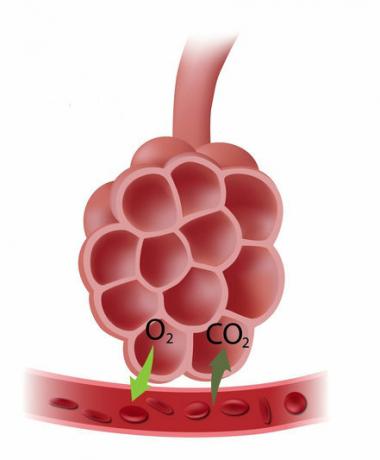The human body performs two types of breathing: The cell and the pulmonary. The first is a process that takes place inside cells and is responsible for obtaining energy. The second, in turn, is responsible for provide oxygen for the cells to carry out cellular respiration and remove the carbon dioxide resulting from this process from our body.
Pulmonary breathing begins with the entry of air through the nasal cavities. In this region, the air is filtered and moistened thanks to the presence of hair and mucus. Furthermore, because the connective tissue in the nasal cavity is extensively vascularized, the air is heated in this location. In the nasal passages, there are also sensory cells that allow the sense of smell.
After passing through the nasal passages, the air moves towards the pharynx, a structure common to the digestive system and respiratory. Then it goes towards the larynx, which is a long tube where there is a small retention of particles and where the vocal folds are located, which allow speech.
Connected to the larynx, is located the trachea, a tube made up of 15 to 20 pieces of cartilage in the shape of a C that prevent this structure from collapsing. In the trachea, there is richly vascularized tissue that allows the air to remain moist and warm. In addition, there are seromucous glands and goblet cells that produce a secretion that acts to remove particles. The cilia present at this location help to move the mucus along with the particles to the pharynx, where it is swallowed.
The trachea then bifurcates in two bronchi, that penetrate the lungs. The bronchi branch until they result in bronchioles, which also branch out. As in the trachea, the air is warmed, humidified and cleaned in the bronchi and bronchioles region.
At the end of the bronchioles are the pulmonary alveoli, which are structures that resemble small bags or chambers. These structures are very close to the capillaries, a characteristic that allows gas exchange, known as hematosis.

The hematosis process occurs in the pulmonary alveoli
In capillaries, oxygen present within the alveoli diffuses into the capillary and binds to hemoglobin. Oxygen is then carried by the blood to every cell in the body so that it can be used for cellular metabolism. The carbon dioxide present in the blood, in turn, takes the opposite path, passing from the capillaries to the interior of the alveoli, from where it travels through the airways to the outside of the body.
The lung breathing process is only possible thanks to two breathing movements: a inspiration, which guarantees the entry of air, and the expiration, that allows air to escape. On inspiration, the diaphragm muscle descends and the intercostal muscles contract. This causes an increase in the rib cage and a decrease in pressure inside it, allowing the entry of air. On exhalation, the diaphragm rises, the intercostal muscles relax, the rib cage decreases and the pressure inside increases, forcing the air to escape.
By Ma. Vanessa dos Santos
Source: Brazil School - https://brasilescola.uol.com.br/biologia/respiracao-pulmonar.htm

